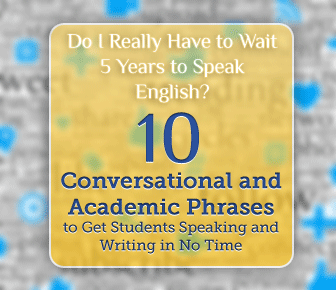Do I Really Have to Wait 5 Years to Speak English?: 10 Conversational and Academic Phrases to Get Students Speaking and Writing in No Time


This is one of the largest complaints of traditional language instruction, and in all fairness, there are a number of culprits: the small amount of time devoted to language learning being one. But another concern is the means of instruction and the curriculum. If students spend large amounts of time conjugating verbs, they won’t be able to string two words together for a conversation. Even if they focus on vocabulary, but learn words in lists, students still won’t be able to string two words together. But if second language students learn language as a set of useful, everyday phrases — How are you? I’m fine. It’s really hot today — they can begin to string two words together. Students are in language class for a limited amount of time, often as little as three hours a week, and this time should be spent on language they can use.
Most of language is formulaic, research has shown—even native speakers, in the pressure of online production, often fall back on formulas: e.g., “Have a nice day,” and “You, too!”

The following phrases have been found to be among the most common in English, in The Grammar of Written and Spoken English, by Biber and his colleagues (1999).
Sentence Starters:
These phrases are useful in that they can be used to start a sentence or even an entire conversation; the student, having memorized the first part, need only fill in the second part. As a student of Russian, for example, I made ample usage of the phrase “Ya doomayo shto—“ (“I think that—“), thereby signaling to the other participants in the conversation that I had a point to make and allowing me time to put that thought together. Many of the following phrases can be used in a similar manner. And they all can be used again and again, on a number of topics, explaining their commonality in the language:
To demonstrate a lack of understanding or lack of agreement on a topic:
I don’t think—
I don’t know—
For storytelling or recounting a conversation:
I went to the—
And I said—
For commands or requests
Have a look at—
Can I have a—
Complete Sentence Responses
In response to a point made by another speaker, keeping the listener involved in the conversation
That’s a good idea.
I don’t like it.

Even a significant portion of academic prose is comprised of “ready-made” formulaic expressions—readers of this genre expect a certain kind of language, and in using it, the writer demonstrates his membership is this community. Teaching students this language therefore helps them enter the academic writing community. Below are some of the formulaic phrases used in academic writing and their functions.
Introductions
With the following, the writer introduces a topic or an example.
In the case of—
The nature of the—
Cause/Effect
As a result of —
Addition
In addition to the—
Comparison
With the following phrase, the author compares an example or point with one previously mentioned.
In the same way—
Comparison
At the same time-- (This seems like a phrase to show comparison, but it is most often used for contrast: “I really like dogs…at the same time, I like cats as well…”)
Enumerating Points
In the first place—

Students must first be aware of the formulas that exist in everyday language and how to respond: the way many Americans today respond to “Thank you,” for example, is not “You’re welcome” but rather “No problem.” This kind of actual, “real-world” language use is often not taught in textbooks because it tends to be highly specialized to time and place: in certain regions or by specific age groups. For example, once in when getting my laptop repaired, the customer service representative helping me responded “No problem” to my “Thank you” and then quickly retracted it with “I don’t mean to suggest there was a problem….” When I assured him I understood what he meant by “no problem,” he went on to tell about a previous customer who was annoyed with his use of “no problem,” thinking he was suggesting that there was indeed one in serving her. Even native speakers, apparently, can misunderstand idiomatic, formulaic phrases, and should keep in mind their actual usage rather than the literal meaning.
Besides conversation, students can study their course readings for use of academic phrases. Opening any academic text to a random page is likely to reveal several academic phrases. Call students’ attention to them: “What words does the author use to introduce the topic?” “How does the author use the phrase ‘in other words’ here?” This will demonstrate the many kinds of phrases and ways they are used in academic writing.
The next step, after exposing students to a variety of conversational and academic phrases, is having students match phrases to their meaning or function: e.g., “No problem”=“You’re welcome.” This provides additional processing with the phrases.
Most phrases comprise an incomplete sentence or thought; they are just the stem or beginning of a thought or sentence. Take advantage of this structure by having students complete sentences: e.g., “I want to—“ or “Do you know—“ in conversation, perhaps with index cards that have been passed out with the key phrase written on it.
In writing, students can complete sentences that begin with the more academic “In the case of—“ or “On the other hand—“
Students can extend the activities above, perhaps structuring an entire conversation or essay around the key phrases.
The instructor may also give out a handout of the key phrases and have students work as many as possible into a conversation or essay.
Learning these phrases, however does not come “naturally”—even native speakers sometimes joke about calling up the wrong formulaic phrases in conversation, such as “You, too” to a waiter’s “Have a good meal.” So while they exist on the automatic level, phrases do need to be consciously learned. Engaging in consciousness-raising and practice provides the processing that students need to learn these phrases to become more fluent in their second language.